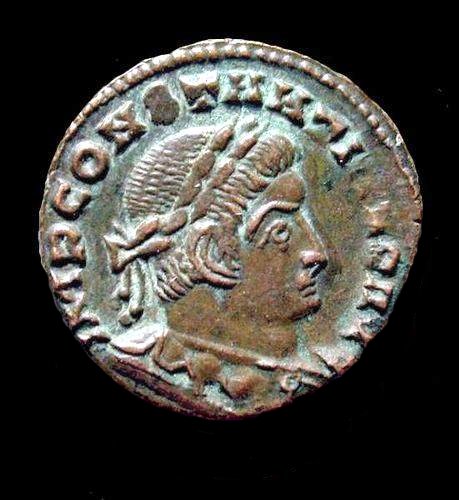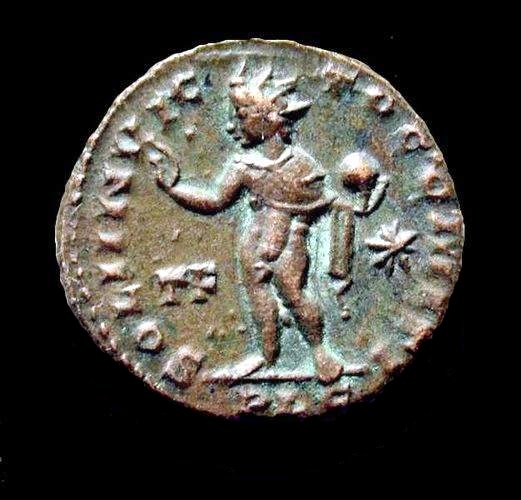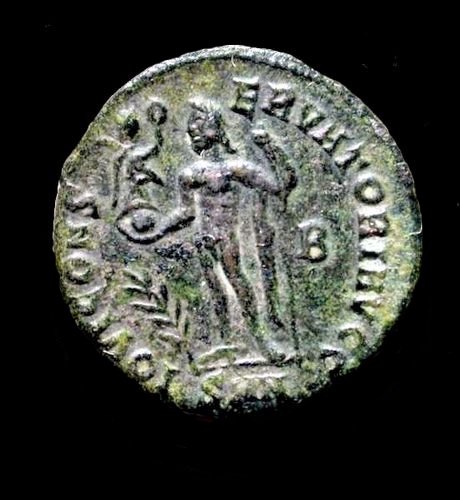

AE3, Constantine I, the Great, AD 307 - 337 |
 |
 |
C. Flavius Valerius Constantinus, son of Constantius Chlorus and Helena, served under Diocletian and Galerius in the East. He subsequently joined his father in Gaul and Britain. When Constantius I died in AD 306 Constantine was proclaimed junior emperor by the army and recognised as Galerius' successor. The following year he married Fausta, daughter of Maximian. Constantine invaded Italy in AD 312 and defeated Maxentius at the Milvian bridge. On his way to Rome, according to Eusebius, Constantine had a vision of the cross of Christ inscribed "In this conquer". A second vision at the walls of Rome inspired Constantine to have the Christian monogram chi and rho displayed on his soldiers' shields. Constantine entered Rome as Augustus and shared power with Licinius until AD 323. After a final victory over Licinius Constantine became sole ruler and reunited the empire. In AD 315 Constantine celebrated his decennalia, his vicennalia first in the East in AD 325, then also at Rome the next year. In AD 330 he established a new imperial residence at Byzantium and renamed the city Constantinople. He celebrated his tricennalia in AD 335. Constantine died in AD 337 and was baptised on his deathbed as a Christian. He was succeeded by his three sons who divided the empire between themselves. Obv. Constantine I laureate right, IMP. CONSTANTINVS AVG.Rev. Radiate Sol standing left, holding orb, in field TF, star, in ex. PLG. |
AE3, Constantine I, the Great, AD 307 - 337 |
| |
|
Constantine is the first emperor since Trajan to be depicted beardless. Initially the disappearance of the beard on Constantine's coinage was intended to stress his descent as the son of Constantius, one of the first tetrarchs, but after AD 324, the tetrarchic portrait was replaced by the clean-shaven look, recalling the classical portraiture of a former period. After AD 312 Constantine adopted a hairstyle that capped the face with comma-shaped locks similar to those displayed on the coinage of Augustus and Trajan. Obv. Constantine I laureate, cuirassed bust right, CONSTANTINVS P. F. AVG. |
AE3, Constantine I, the Great, AD 307 - 337 |
| |
|
Constantinian reverse types also showed innovation. Initially Constantine was associated with Jupiter, Hercules and Sol on coins. Early in his reign, until AD 316, the predominant reverse type for bronze at Constantinian mints was Sol - the type disappeared after AD 318 in the western mints) and Jupiter for Licinius in the East. Constantine claimed the protection of Sol who allegedly appeared to him in a vision as an omen of success in AD 310. Gradually Sol was replaced by more neutral personifications like Victory or other military themes, for instance, depictions of soldiers holding standards. After AD 324 reverse types mainly displayed themes like the glory of the army (GLORIA EXERCITVS) and the safety of the state (SECVRITAS REIPVBLICAE). Coins of Helena feature the personification Securitas holding a branch and pallium. Obv. Constantine I right, IMP. CONSTANTINVS P. F. AVG. |
AE3, Constantine I, the Great, AD 307 - 337 |
 |
 |
The turreted gateway as a reverse type became popular during the Licinian and Constantinian periods of civil war. The reverse legend often reads PROVIDENTIAE AVGG (the foresight of the rulers, mainly Constantine and his sons). This military type usually depicts a gate set in a block-like structure, a wall or a tower surmounted by turrets (beacons), within the wall doors or door openings. At the top turrets are displayed - on the frontier these were used to signal the next fortification in line. Some camp-gates are decorated with arches and dots in the top row. From AD 324 Constantine's features become more idealised. Apart from his aquilline nose individual features disappear. The hair spreads backwards in waves, curling down in the neck. Constantine is depicted facing slightly upward, with large eyes staring into the heavens. Obv. Constantine I right, CONSTANTINVS AVG.Rev. A camp-gate surmounted by two turrets, star, SMANT. |
AE3, Constantine I, the Great, AD 307 - 337 |
 |
 |
The laureate obverse for Augusti and Caesars changed around AD 326 - the laurel wreath was replaced by a diademed head-dress, consisting of either rows of pearls or rosettes. Portraiture often shows Constantine gazing towards the heavens. Obv. Constantine I diademed left, IMP. CONSTANTINVS AVG. |
| Republican | Imperatorial | |
Greek Imperial | Byzantine |